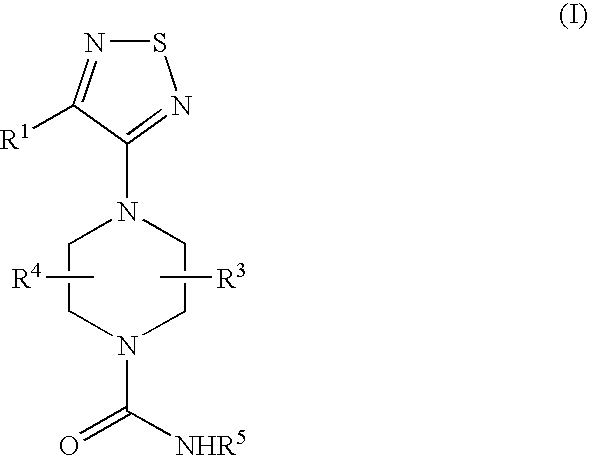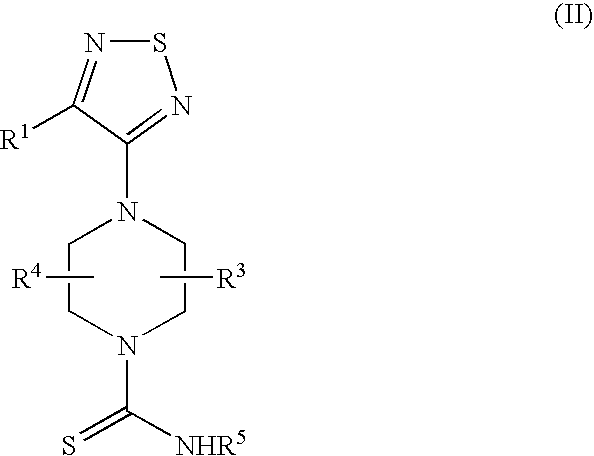Therapeutic agents useful for treating or preventing pain
a technology of thiadiazolylpiperazine and therapeutic agents, which is applied in the field of thiadiazolylpiperazine compounds to achieve the effect of inhibiting the function of mglur5
- Summary
- Abstract
- Description
- Claims
- Application Information
AI Technical Summary
Problems solved by technology
Method used
Image
Examples
example 1
Synthesis of Compounds AAV, AAW, and ABA
[0408] 20
[0409] To compound 1b (1.2 g, 6.45 mmol) dissolved in 4 mL of DMSO was added DIEA (1.12 mL, 6.45 mmol), followed by 3,4-dichloro-1,2,5-thiadiazo-lylpiperazine 1a (500 mg, 3.23 mmol) and the resulting reaction mixture allowed to stir at 100.degree. C. for 16 hrs. The reaction mixture was then cooled to room temperature and water and ethyl acetate were added to the reaction mixture. The ethyl acetate phase and an aqueous phase were then separated and the aqueous phase was extracted twice with ethyl acetate; the ethyl acetate phases combined; and the ethyl acetate phases washed with water, washed with brine, dried (sodium sulfate), and concentrated under reduced pressure to provide compound 1c which was purified by silica gel chromatography using ethyl acetate / dichloromethane as the eluant. To compound 1c (943 mg, 3.1 mmol) dissolved in 10 mL of ethyl acetate was added hydrochloric acid (4 M in dioxane, 7.7 mL, 30.7 mmol) and the resulti...
example 2
Binding of the Thiadiazolylpiperazine Compounds to the Human VR1 Receptor
[0419] VR1 antagonism has been associated with the prevention of pain (See, e.g., R. Wrigglesworth and C. Walpole, "Capsaicin-like Agonists," Drugs of the Future, 23(5), pp. 531-538 (1998); S. Bevan P. McIntyre, "Vanilloid Receptors: Pivotal Molecules in Nocciception," Current Opinions in CPNS Investigational Drugs, vol. 2, no. 2, pp. 178-185 (2000) and A. Szallash and P. Blumberg, "Vanilloid (Capsaicin) Receptors and Mechanisma," Pharmacology Reviews, vol. 51, no. 2, pp. 159-211 (1999)).
[0420] Methods for assaying compounds capable of inhibiting VR1 are well known to those skilled in the art, for example, those methods disclosed in U.S. Pat. No. 6,239,267 to Duckworth et al.; U.S. Pat. No. 6,406,908 to McIntyre et al.; or U.S. Pat. No. 6,335,180 to Julius et al.
[0421] Typically, the Thiadiazolylpiperazine Compounds have an IC.sub.50 value for inhibition of capsaicin-induced activation that is less than 25 .mu....
example 3
5.3. Example 3
Binding of Thiadiazoleiperazine Compounds to mGluR5.
[0423] The following astrocyte assay can be used to demonstrate that Thiadiazolylpiperazine Compounds bind to and modulate the activity of mGluR5.
[0424] Cell cultures: Primary glial cultures are prepared from cortices of Sprague-Dawley 18 days old embryos. The cortices are dissected and then dissociated by trituration. The resulting cell homogenate is plated onto poly-D-lysine precoated T175 flasks (BIOCOAT, commercially available from Becton Dickinson and Company Inc. of Franklin Lakes, N.J.) in Dulbecco's Modified Eagle's Medium ("DMEM," pH 7.4), buffered with 25 mM HEPES, and supplemented with 15% fetal calf serum ("FCS," commercially available from Hyclone Laboratories Inc. of Omaha, Nebr.), and incubated at 37.degree. C. and 5% CO.sub.2. After 24 hours, FCS supplementation is reduced to 10%. On day six, oligodendrocytes and microglia are removed by strongly tapping the sides of the flasks. One day following this ...
PUM
| Property | Measurement | Unit |
|---|---|---|
| temperature | aaaaa | aaaaa |
| temperature | aaaaa | aaaaa |
| volume | aaaaa | aaaaa |
Abstract
Description
Claims
Application Information
 Login to View More
Login to View More - R&D
- Intellectual Property
- Life Sciences
- Materials
- Tech Scout
- Unparalleled Data Quality
- Higher Quality Content
- 60% Fewer Hallucinations
Browse by: Latest US Patents, China's latest patents, Technical Efficacy Thesaurus, Application Domain, Technology Topic, Popular Technical Reports.
© 2025 PatSnap. All rights reserved.Legal|Privacy policy|Modern Slavery Act Transparency Statement|Sitemap|About US| Contact US: help@patsnap.com



